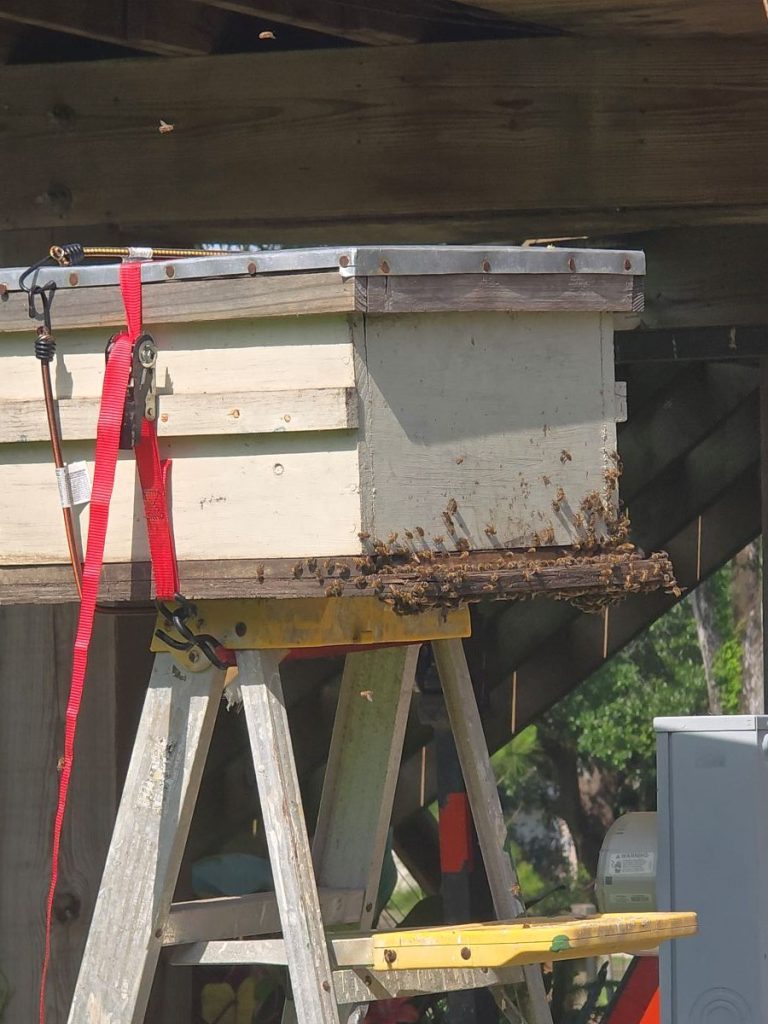Understanding the Relationship: Honeybee-Flower Interaction
Published 3:17 pm Tuesday, May 27, 2025

- Two of the three colonies started migrating to the new (temporary) hives. The Queen from each hive was relocated to the new residence. This required the assistance of a Master Beekeeper (Len VanMarion) over the course of a week. It is important to note bees release “attack” phermones during the process and will become highly aggitated for several days (image courtesy: John Green)
|
Getting your Trinity Audio player ready...
|
This spring, we experienced the “good fortune” of three honeybee colonies choosing to cohabitate with us- deciding to take up residence beneath our home. Approximately one hundred thousand bees were building combs and delivering nectar to their newly formed colonies. Many readers may not agree with the “good fortune” word choice having experienced personal, negative consequences of ‘bee-ing’ at the wrong place at the wrong time! Living too close to bees can pose a health risk and challenge for people and pets, especially when bees perceive threats.
This is the third instance where bees have chosen to colonize our home, but it is extremely rewarding to me as an organic gardener knowing that honeybees require significant sources of nectar to sustain and grow the hive.
This may seem to be a significant problem for some gardeners but for me nothing more than a slight nuisance, requiring assistance from a friend (and Master Beekeeper), a bit of manual labor (removing exterior siding and plywood sheeting) to access the bees over the course of several evenings. Hives are set up temporarily near the existing colony, the queen migrated to the new hive with honeycombs, thus creating an environment to allow the bees to be transported to their new home successfully. It’s important that we help honeybees in every way we can, even when it’s inconvenient to us!
Nature is a magnificent force that has fashioned a relationship between flowering plants and a 6-legged flying insect (one in particular) known as the honeybee. Without a flowers’ pollen and nectar, honeybees could not exist and without the honeybee (with its need for nectar and pollen), flowers would not be pollinated…and would cease to exist! Honeybees are responsible for more than two-thirds (approximately 80%) of plant pollination for crops that sustain human life.
Fun Fact: Almond growers in California hire beekeepers to place more than two million hives in their orchards each February to pollinate the almond blooms.
We all need to face the facts and stop taking the honeybee for granted! It’s time for each of us to become more aware of the honeybee and all pollinators, including butterflies! This is a sobering statistic: US beekeepers experienced a significant increase in honeybee colony losses in 2024. Commercial beekeepers reported a 62% average loss between June’24 to Mar’25 which represents an estimated 1.6 million colonies! The economic impact on beekeepers is staggering…more than $600 million. Let’s put this into perspective- beekeepers are struggling just to maintain their hive numbers up by splitting their hives yearly. This allows them to “break even” but does not allow for growth.
Unfortunately, there are a few studies which have found that feral hives (wild beehives) will not survive for more than 3 years. The U.S. has been invaded by an Asian mite and an African beetle which are destroying our beehives. Beekeepers must constantly monitor their hives to guard against these predators.
Indiscriminate control of pests and vegetation by way of chemical means such as pesticides, insecticides, and herbicides are proven to be radically destructive to our environment and they destroy beneficial insects, which hamper natural pest control, especially pollinators. An alternative (in my opinion the best approach to gardening) for gardeners is to select organic products to assist them reduce detrimental insect populations but only when necessary. We need to understand that if our nonchalant attitude toward pest control continues, the honeybee and butterfly may become nonexistent within the next 100 years.
Perspective
Gardeners, ask yourselves these questions: How many butterflies do you see daily? How many honeybees do you see on flowers? Do you wonder why the cucumbers, melons, and squash aren’t yielding? Do you spray pesticides on flowers, roses, and trees? Have you used weed & feed on the lawn? Are sprays used to the lawn to kill fire ants?
Face it, none of us are blameless but we can change! We simply need to shift our approach to gardening and become less impactful and more environmentally sensitive. Utilizing organic controls and spraying flowers or vegetable gardens after sunset (late evening) will assist beneficial insects, especially honeybees!
Maintaining healthy plants and continued blooming will aid local honeybee populations and prove rewarding by increasing vegetable and crop yields. It is critically important for each of us to support our local beekeepers by using fewer chemicals with focused attention and caution if applying pesticides.
Reach out to the local Texas A&M AgriLife Extension Office, as they will have a list of local beekeepers to contact for each of us to purchase honey from our LOCAL BEEKEEPER’s.
Special thanks to a friend, Len VanMarion, who was instrumental in relocating the honeybees. Len is a Certified Texas Master Gardener, TAIS Master Beekeeper, and member of Texas Beekeepers & Real Texas Honey Associations. So long for now fellow gardeners, let’s go out and grow ourselves a greener, more sustainable world, by saving one honeybee at a time! For answers to your gardening questions, send me an email: jongreene57@gmail.com.





